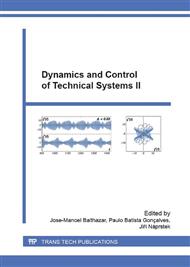[1]
M.C. Pereira, H.I. Weber, In: plane position of a rotary arm using a reaction wheel. Proceedings of DINCON'11, Águas de Lindóia, Brazil, pp.136-139, (2011).
Google Scholar
[2]
M. Spong, P. Corke and R. Lozano, In: Nonlinear control of the Reaction Wheel Pendulum, Automatica #37 pp.1845-1851, (2001).
DOI: 10.1016/s0005-1098(01)00145-5
Google Scholar
[3]
K.J. Åström, K. Furuta, M. Iwashiro, and T. Hoshino, In: Energy based strategies for swinging up a double pendulum, IFAC World Congress. Beijing, China, (1995).
DOI: 10.1016/s1474-6670(17)57101-3
Google Scholar
[4]
J. Awrejcewicz and G. Kudra, In: Dynamics of a real triple pendulum – modeling and experimental observation, ENOC 2008, St. Petersburg, Russia, (2008).
Google Scholar
[5]
M.C. Pereira, H.I. Weber, In: Analysis of the oscillation of a self-excited pendulum due to varying length, Proceedings of PANACM'2015, Buenos Aires, Argentina, pp.272-280, (2015).
Google Scholar
[6]
K.J. Åström and K. Furuta, In: Swinging up a pendulum by energy control, Automatica 36, 287-295, (2000).
DOI: 10.1016/s0005-1098(99)00140-5
Google Scholar
[7]
M. Bugeja, In: Non-linear swing-up and stabilizing control of an inverted pendulum system, Proceedings of the IEEE Int. Conf. on Computer as a Tool, EUROCON'03, Ljubljana, Slovenia (2003).
DOI: 10.1109/eurcon.2003.1248235
Google Scholar
[8]
G. Zhai, In: Swinging up and Stabilizing an Inverted Pendulum by Switching Control, International Conference on Mechatronics and Automation, ICMA 2007, pp.521-526, (2007).
DOI: 10.1109/icma.2007.4303597
Google Scholar
[9]
C.C. Chung and J. Hauser, In: Nonlinear control of a swinging pendulum, Automatica, 31: 6, p.851–862, (1995).
DOI: 10.1016/0005-1098(94)00148-c
Google Scholar
[10]
A.M. Tusset, V. Piccirillio, A.M. Bueno ; J.M. Balthazar, D. Sado, J.L.F. Palacios and R.M.L.R.F. Brasil, In: Chaos control and sensitivity analysis of a double pendulum arm excited by an RLC circuit based nonlinear shaker. Journal of Vibration and Control, pp.1-17, (2015).
DOI: 10.1177/1077546314564782
Google Scholar
[11]
R.H. Avanço, H.A. Navarro, J.M. Balthazar, A.M. Bueno and A.M. Tusset, In: Statements on nonlinear dynamics behavior of a pendulum, excited by a crank-shaft-slider mechanism, Meccanica (Milano. Print), pp.1-20, (2015).
DOI: 10.1007/s11012-015-0310-1
Google Scholar
[12]
K. Magnus, In: Vibrations, Blackie & Son Limited, Glasgow, (1965).
Google Scholar
[13]
S.H. Strogatz, In: Nonlinear Dynamics and Chaos: with Applications to Physics, Biology, Chemistry and Engineering, Perseus, (1994).
Google Scholar


